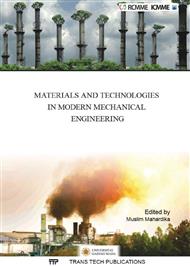[1]
J. N. Pires, A. Loureiro, T. Godinho, P. Ferreira, B. Fernando, and J. Morgado, Welding robots, Robotics & Automation Magazine, IEEE, vol. 10, no. 2, p.45–55, (2003).
DOI: 10.1109/mra.2003.1213616
Google Scholar
[2]
T. Sugar and V. Kumar, Control and coordination of multiple mobile robots in manipulation and material handling tasks, in Experimental Robotics VI, p.15–24, Springer, (2000).
DOI: 10.1007/bfb0119381
Google Scholar
[3]
A. Gasparetto, R. Vidoni, D. Pillan, and E. Saccavini, Automatic path and trajectory planning for robotic spray painting, in Robotics; Proceedings of ROBOTIK 2012; 7th German Conference on, p.1–6, VDE, (2012).
DOI: 10.1115/esda2010-24259
Google Scholar
[4]
R. Letz, M. G. Cherniack, F. Gerr, D. Hershman, and P. Pace, A cross sectional epidemiological survey of shipyard workers exposed to handarm vibration., British journal of industrial medicine, vol. 49, no. 1, p.53–62, (1992).
DOI: 10.1136/oem.49.1.53
Google Scholar
[5]
M. Bovenzi, A. Fiorito, and C. Volpe, Bone and joint disorders in the upper extremities of chipping and grinding operators, International archives of occupational and environmental health, vol. 59, no. 2, p.189–198, (1987).
DOI: 10.1007/bf00378496
Google Scholar
[6]
H. Asada and Y. Asari, The direct teaching of tool manipulation skills via the impedance identification of human motions, in International Conference on Robotics and Automation, p.1269–1274, IEEE Comput. Soc. Press, (1988).
DOI: 10.1109/robot.1988.12235
Google Scholar
[7]
D. Ludvig and E. J. Perreault, System identification of physiological systems using short data segments., Transactions on Bio-medical engineering, vol. 59, p.3541–9, Dec. (2012).
DOI: 10.1109/tbme.2012.2220767
Google Scholar
[8]
G. Byrne and G. ODonnell, An integrated force sensor solution for process monitoring of drilling operations, CIRP AnnalsManufacturing Technology, vol. 56, no. 1, p.89–92, (2007).
DOI: 10.1016/j.cirp.2007.05.023
Google Scholar
[9]
M. B. Jun, O. B. Ozdoganlar, R. E. DeVor, S. G. Kapoor, A. Kirchheim, and G. Schaffner, Evaluation of a spindle-based force sensor for monitoring and fault diagnosis of machining operations, International Journal of Machine Tools and Manufacture, vol. 42, no. 6, p.741–751, (2002).
DOI: 10.1016/s0890-6955(01)00156-0
Google Scholar
[10]
H. Ohzeki, A. Mashine, H. Aoyama, and I. Inasaki, Development of a magnetostrictive torque sensor for milling process monitoring, Journal of manufacturing science and engineering, vol. 121, no. 4, p.615–622, (1999).
DOI: 10.1115/1.2833078
Google Scholar
[11]
A. A. Sarhan, A. Matsubara, S. Ibaraki, and Y. Kakino, Monitoring of cutting force using spindle displacement sensor, in Proc. of the 2004 Japan-USA Symposium on Flexible Automation, Denver, (2004).
Google Scholar
[12]
A. A. D. Sarhan, A. Matsubara, M. Sugihara, H. Saraie, S. Ibaraki, and Y. Kakino, Monitoring method of cutting force by using additional spindle sensors, JSME International Journal Series C, vol. 49, no. 2, p.307–315, (2006).
DOI: 10.1299/jsmec.49.307
Google Scholar
[13]
Y. Altintas, Prediction of cutting forces and tool breakage in milling from feed drive current measurements, Journal of Engineering for Industry, vol. 114, no. 4, p.386–392, (1992).
DOI: 10.1115/1.2900688
Google Scholar
[14]
J. Lee, D. Choi, J. Kim, and C. Chu, Real-time tool breakage monitoring for nc milling process, CIRP Annals-Manufacturing Technology, vol. 44, no. 1, p.59–62, (1995).
DOI: 10.1016/s0007-8506(07)62275-6
Google Scholar
[15]
D. Campolo, L. Schenato, L. Pi, X. Deng, and E. Guglielmelli, Multimodal sensor fusion for attitude estimation of micromechanical flying insects: a geometric approach, in Intelligent Robots and Systems, 2008. IROS 2008. IEEE/RSJ International Conference on, p.3859– 3864, IEEE, (2008).
DOI: 10.1109/iros.2008.4650812
Google Scholar
[16]
L. Schenato, W. C. Wu, and S. Sastry, Attitude control for a micromechanical flying insect via sensor output feedback, Robotics and Automation, IEEE Transactions on, vol. 20, no. 1, p.93–106, (2004).
DOI: 10.1109/tra.2003.820863
Google Scholar
[17]
J. Wessnitzer and B. Webb, Multimodal sensory integration in insectstowards insect brain control architectures, Bioinspiration & biomimetics, vol. 1, no. 3, p.63, (2006).
DOI: 10.1088/1748-3182/1/3/001
Google Scholar
[18]
R. M. Murray, Z. Li, S. S. Sastry, and S. S. Sastry, A mathematical introduction to robotic manipulation. CRC press, (1994).
Google Scholar


